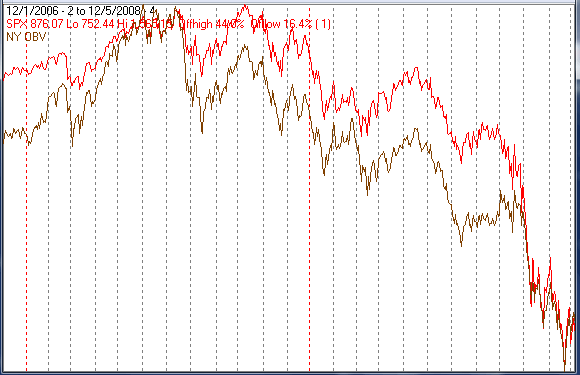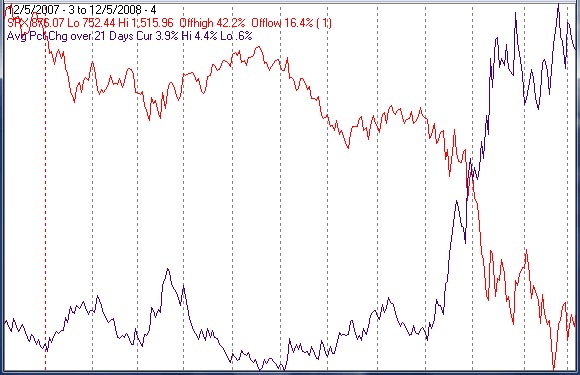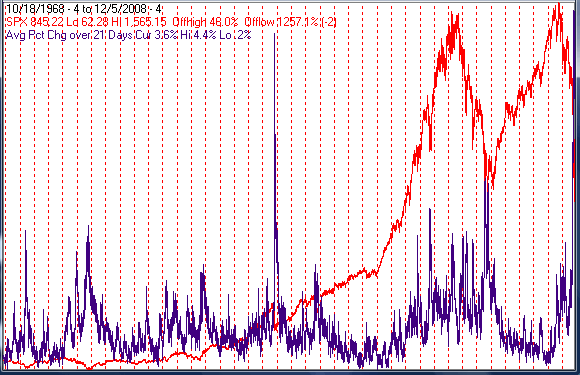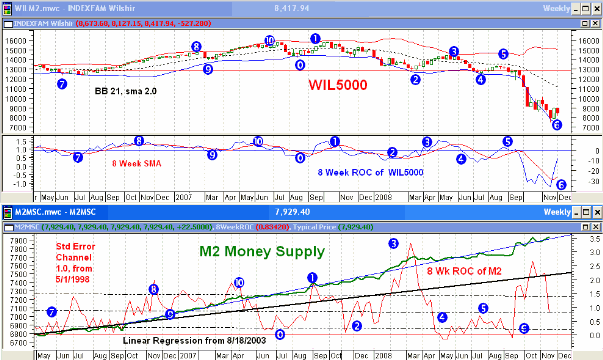Stock Market Technicals Point to Santa Rally
Stock-Markets / US Stock Markets Dec 06, 2008 - 11:44 AM GMTBy: Mike_Burk
 The good news is: Downside volume has been fading quickly.
The good news is: Downside volume has been fading quickly.
Short Term Downside volume and new lows are the best indicators of bottoms.
Following a bottom, new lows and downside volume diminish rapidly and, although the major averages were down last week, indicators derived from new lows and downside volume showed improvement last week.
The chart below covers the past 6 months showing the NASDAQ composite (OTC) in blue and a 5% trend (19 day EMA) of NASDAQ downside volume (OTC DV) in brown. OTC DV has been plotted on an inverted Y axis so decreasing downside volume moves the indicator upward (up is good). Dashed vertical lines have been drawn on the 1st trading day of each month.
OTC DV has been moving sharply upward since the November low.

The chart below covers the past 6 months showing the S&P 500 (SPX) in red and an indicator called On Balance Volume (OBV) that is a running total of daily declining volume subtracted from advancing volume (an advance - decline line of volume) in brown.
The indicator moved to a high, relative to the November low, last week.

Some indicators are biased to the upside and others are biased to the downside and sometimes the bias changes.
The chart below shows the same index and indicator as the chart above except it covers the past 2 years. The dashed vertical lines are red on the 1st trading day of the year.
This indicator has been doing a pretty good job over the intermediate term. It confirmed the high in July of 2007 but failed to confirm the top of October 2007. Now, as can be seen on the chart above, it is leading the way upward.

Basing a decision on one weeks performance of an intermediate term indicator is reckless, but there is hope.
Intermediate term
I keep repeating, because it is important, although there were fewer new lows at the November low than there were at the October low, the November numbers were so high that, at least, a retest of the November lows is likely.
Volatility increases during declines and near bottoms.
Recently we have seen the highest volatility since the crash of 1929.
The chart below covers the past year showing the SPX in red and an indicator showing the average daily percentage change of the SPX over the past 21 trading days in black. The indicator hit a high of 4.4% at the November low, the highest reading since October of 1929.

The next chart shows the same index and indicator except it covers the past 40 years beginning in 1968. Dashed vertical lines have been drawn on the 1st trading day of each year. The spike in the middle of the chart is the crash of 1987 when the indicator hit 4.0%.

The next chart shows the same index and indicator from just before the 1929 crash through late 1939. The high level for the indicator in the 1930's was 4.0% hit in October 1931. Following that indicator high the SPX rallied 30.6% in a month before falling another 60% over the next 7 months.

Seasonality
Next week is the week prior to the 2nd Friday in December during the 4th year of the Presidential Cycle.
The tables show the daily return on a percentage basis for the week prior to the 2nd Friday of December during the 4th year of the Presidential Cycle. NASDAQ composite (OTC) data covers the period from 1963 - 2007 and SPX data from 1953 - 2007. There are summaries for both the 4th year of the Presidential Cycle and all years combined. Prior to 1953 the market traded 6 days a week so that data has been ignored.
Over all periods there have been modest gains with the indices up about half of the time.
Report for the week before the 2nd Friday of December
The number following the year is the position in the presidential cycle.
Daily returns from Monday to 2nd Friday.
| OTC Presidential Year 4 | ||||||
| Year | Mon | Tue | Wed | Thur | Fri | Totals |
| 1964-4 | 0.09% | -0.23% | -0.23% | -0.34% | 0.16% | -0.55% |
| 1968-4 | -0.24% | 0.11% | 0.00% | -0.04% | -0.13% | -0.30% |
| 1972-4 | 0.15% | 0.10% | 0.30% | 0.28% | 0.07% | 0.90% |
| 1976-4 | 0.35% | 0.41% | 0.39% | 0.78% | 0.55% | 2.48% |
| 1980-4 | -3.52% | -0.41% | -0.76% | -2.50% | 1.31% | -5.88% |
| 1984-4 | -0.18% | 0.12% | -0.05% | -0.25% | 0.40% | 0.04% |
| Avg | -0.69% | 0.07% | -0.03% | -0.34% | 0.44% | -0.55% |
| 1988-4 | 0.40% | 0.42% | -0.17% | -0.30% | -0.01% | 0.35% |
| 1992-4 | 0.75% | 0.09% | -0.48% | -0.75% | -0.48% | -0.87% |
| 1996-4 | 2.22% | -0.28% | -0.27% | -0.82% | -1.03% | -0.18% |
| 2000-4 | -1.12% | 10.47% | -3.23% | -1.57% | 5.98% | 10.55% |
| 2004-4 | 0.15% | -1.70% | 0.54% | 0.14% | -0.04% | -0.91% |
| Avg | 0.48% | 1.80% | -0.72% | -0.66% | 0.89% | 1.78% |
| OTC summary for Presidential Year 4 1964 - 2004 | ||||||
| Avg | -0.09% | 0.83% | -0.40% | -0.49% | 0.62% | 0.51% |
| Win% | 64% | 64% | 30% | 27% | 55% | 45% |
| OTC summary for all years 1963 - 2007 | ||||||
| Avg | 0.06% | 0.08% | -0.02% | -0.30% | 0.19% | 0.02% |
| Win% | 60% | 51% | 52% | 47% | 56% | 51% |
| SPX Presidential Year 4 | ||||||
| Year | Mon | Tue | Wed | Thur | Fri | Totals |
| 1956-4 | -0.51% | -0.68% | -0.75% | 0.80% | 0.09% | -1.06% |
| 1960-4 | -0.14% | 0.29% | 0.99% | 0.23% | 0.89% | 2.26% |
| 1964-4 | -0.02% | -0.39% | -0.64% | -0.01% | 0.25% | -0.82% |
| 1968-4 | -0.25% | -0.25% | 0.00% | -0.07% | 0.24% | -0.32% |
| 1972-4 | 0.33% | -0.16% | 0.37% | 0.50% | 0.22% | 1.26% |
| 1976-4 | 0.78% | -0.07% | 0.57% | 0.41% | 0.18% | 1.88% |
| 1980-4 | -2.55% | -0.10% | -1.70% | -0.70% | 1.47% | -3.59% |
| 1984-4 | 0.07% | 0.42% | -0.27% | -0.50% | 0.54% | 0.27% |
| Avg | -0.32% | -0.03% | -0.26% | -0.07% | 0.53% | -0.10% |
| 1988-4 | 1.15% | 0.97% | 0.19% | -0.56% | 0.17% | 1.92% |
| 1992-4 | 0.75% | 0.39% | -0.31% | -0.23% | -0.21% | 0.39% |
| 1996-4 | 1.37% | -0.30% | -0.91% | -1.54% | -0.09% | -1.47% |
| 2000-4 | 0.74% | 3.89% | -1.82% | -0.59% | 1.96% | 4.19% |
| 2004-4 | -0.08% | -1.11% | 0.49% | 0.54% | -0.10% | -0.26% |
| Avg | 0.79% | 0.77% | -0.47% | -0.48% | 0.34% | 0.95% |
| SPX summary for Presidential Year 4 1956 - 2004 | ||||||
| Avg | 0.13% | 0.22% | -0.32% | -0.13% | 0.43% | 0.36% |
| Win% | 54% | 38% | 42% | 38% | 77% | 54% |
| SPX summary for all years 1953 - 2007 | ||||||
| Avg | 0.13% | 0.06% | 0.00% | -0.25% | 0.19% | 0.12% |
| Win% | 58% | 46% | 50% | 40% | 65% | 53% |
Money supply (M2)
The chart below was provided by Gordon Harms. Money supply has growth fell off sharply over the most recent period.

Conclusion
Conditions are in place that would support a rally of a month or two.
I expect the major indices to be higher on Friday December 12 than they were on Friday December 5.
Thank you,
By Mike Burk
To subscribe to this report : http://alphaim.net/signup.html
Gordon Harms produces a Power Point for our local timing group. You can get a copy of that at: http://www.stockmarket-ta.com/ .
Disclaimer: Mike Burk is an employee and principal of Alpha Investment Management (Alpha) a registered investment advisor. Charts and figures presented herein are believed to be reliable but we cannot attest to their accuracy. Recent (last 10-15 yrs.) data has been supplied by CSI (csidata.com), FastTrack (fasttrack.net), Quotes Plus (qp2.com) and the Wall Street Journal (wsj.com). Historical data is from Barron's and ISI price books. The views expressed are provided for information purposes only and should not be construed in any way as investment advice. Furthermore, the opinions expressed may change without notice.
Mike Burk Archive |
© 2005-2022 http://www.MarketOracle.co.uk - The Market Oracle is a FREE Daily Financial Markets Analysis & Forecasting online publication.



